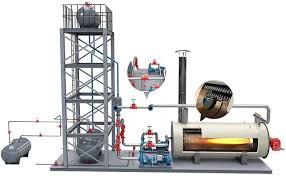
Dec . 11, 2024 02:18 Back to list
Understanding the Process of Steam Production in Boiler Systems
How Steam is Produced by a Boiler
The production of steam is a fundamental process that is widely utilized in various industries, including power generation, manufacturing, and heating. At the heart of this process lies the boiler, a crucial component that efficiently converts water into steam through the application of heat. Understanding how steam is produced by a boiler involves exploring the key principles of thermodynamics, the types of boilers available, and the overall operation of the system.
A boiler operates on a simple yet effective principle water is heated to its boiling point, causing it to transform into steam. This process begins with the introduction of water into the boiler. The design of boilers may vary, but they typically consist of a combustion chamber where fuel is burned to generate heat. Common fuels include natural gas, oil, and coal, though renewable sources are gaining popularity due to environmental concerns.
How Steam is Produced by a Boiler
Boilers can be classified into several types based on their design and operation. The two main categories are fire-tube boilers and water-tube boilers. In fire-tube boilers, hot gases produced from combustion pass through tubes that are surrounded by water. This design is typically more compact and easier to maintain. On the other hand, water-tube boilers have water flowing through tubes that are heated by hot gases, allowing for higher pressure and temperature capabilities. This makes them suitable for large-scale applications, such as power plants.
how steam is produced by a boiler

The steam produced by a boiler can be used for various applications. In power generation facilities, steam drives turbines, which in turn generate electricity. In industrial settings, steam is utilized for processes such as sterilization, heating, and driving machinery. Additionally, boiler steam is crucial for heating systems in residential and commercial buildings, providing warmth and comfort during colder months.
The operation of a boiler is controlled by a series of instruments and safety features. Temperature and pressure gauges monitor the conditions within the boiler, ensuring that they remain within safe limits. The boiler also incorporates safety valves designed to release excess pressure and prevent dangerous situations. Regular maintenance and inspections are essential to keep boilers running efficiently and safely, reducing the risk of accidents or breakdowns.
In recent years, there has been an increasing emphasis on efficiency and sustainability in boiler operations. Modern boilers are designed to maximize fuel efficiency, often incorporating advanced technologies such as condensing systems, which recover and utilize waste heat that would otherwise be lost. Additionally, the push for greener energy sources has led to the exploration of biofuels and electric boilers as eco-friendly alternatives.
In conclusion, the production of steam by a boiler is a vital process that underpins many industrial and commercial applications. Through the efficient conversion of water to steam, boilers provide essential energy needed for various processes and comfort heating. As technology advances, the focus on efficiency and sustainability will continue to shape the evolution of boiler systems, ensuring their relevance in a changing energy landscape.
-
Efficient Biomass Fired Hot Water Boiler | AI Heating Solution
NewsAug.01,2025
-
High-Efficiency Gas Thermal Oil Boilers | HPT Models
NewsJul.31,2025
-
Oil Fired Hot Water Boilers Sale - High Efficiency & Affordable
NewsJul.31,2025
-
High-Efficiency Commercial Oil Fired Steam Boiler for Industry
NewsJul.30,2025
-
High-Efficiency Biomass Fired Thermal Oil Boiler Solutions
NewsJul.30,2025
-
High Efficiency Gas Fired Thermal Oil Boiler for Industrial Heating
NewsJul.29,2025
Related PRODUCTS






















